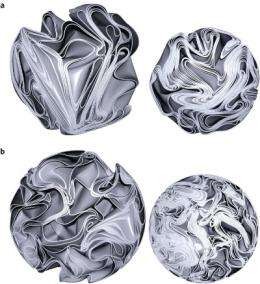August 23, 2011 report
Researchers seek to understand the complexity of crumpled paper balls

(PhysOrg.com) -- Sometimes the simplest of things become complicated and complex when looked at more closely. Gravity is but one example. Another is the mechanics involved in creating a crumpled ball from a single sheet of paper. Why does it end up shaped the way it does, despite the fact that it is created in such a random fashion? And why does it become stronger? Two physicists from the University of Massachusetts , Amherst, Narayan Menon and Anne Dominique Cambou have been looking at such questions and have published their findings in the Proceedings of the National Academy of Sciences.
First of all notes Menon, a piece of paper crumpled at random into a ball, is 90% air. She knows this because she and her partner ran a bunch of them through an X-ray microtomography machine, a device similar to a CT scanner in that it takes image slices of a 3D object that when pieced back together create a whole. Such images of a ball of paper show that in addition to being mostly air, the paper tends to push against itself via flat edges. They also found that the crumpled ball is denser on the outer portions than it is the inner and is the least dense at its core, which is sort of the opposite of other natural spherical structures.
The researchers also found that there doesn’t appear to be any pattern created overall that would lead from one part of it to another. There is no path from in to out, or out to in, for example. The only discernable patterns were the tendencies of flat parts to lie or push up against other flat parts, a phenomenon that appears to have no rational explanation considering the structure was created randomly by random forces. It’s this tendency that appears to be the mechanism between the different parts of the ball that hold the key to its density and ability to resist being further crushed by additional force.
To find deeper or perhaps more profound answers to their questions, the team has begun making short movies of the process involved in the creation of a crumpled ball using transparent paper that they hope will show a process pattern of some sort. They point out that finding out why stuff crumples the way it does could be useful for such things as building better crumple bumpers and barriers to protect people in car accidents. Plus, it’s assumed, it’d just be cool to find out.
More information: Three-dimensional structure of a sheet crumpled into a ball, Proceedings of the National Academy of Sciences, Published online before print August 22, 2011, doi: 10.1073/pnas.1019192108
Abstract
When a thin sheet is crushed into a small three-dimensional volume, it invariably forms a structure with a low volume fraction but high resistance to further compression. Being a far-from-equilibrium process, forced crumpling is not necessarily amenable to a statistical description in which the parameters of the initially flat sheet and the final confinement fully specify the resulting crumpled state. Instead, the internal geometry and mechanical properties of the crumpled ball may reflect the history of its preparation. Our X-ray microtomography experiments reveal that the internal three-dimensional geometry of a crumpled ball is in many respects isotropic and homogeneous. In these respects, crumpling recapitulates other classic nonequilibrium problems such as turbulence, where a system driven by long-wavelength, low-symmetry, forcing shows only rather subtle fingerprints of the forcing mechanism. However, we find local nematic ordering of the sheet into parallel stacks. The layering proceeds radially inward from the outer surface. The extent of this layering increases with the volume fraction, or degree of compression.
via Wired
© 2011 PhysOrg.com



















